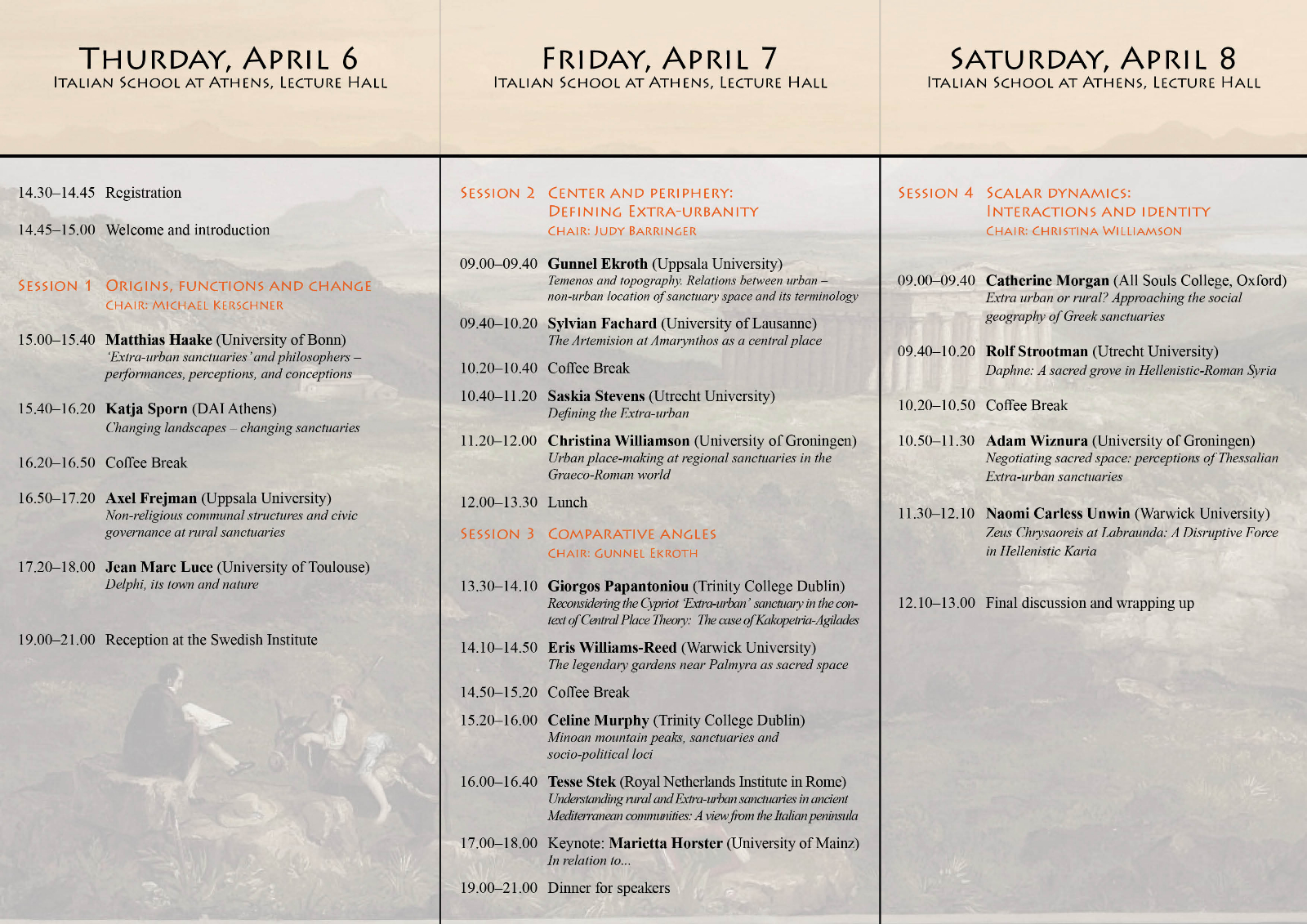Session 4: Scalar Dynamics: Interactions and Identity

Abstracts of Session Papers
Saturday 2023-04-08 | 09:00 | 09:40
Extra urban or rural? Approaching the social geography of Greek sanctuaries
Catherine Morgan (All Souls College, Oxford)
Abstract
This paper draws on recent research into the diverse range of activity at shrines in northwest Greece and especially the Ionian islands, where terrestrial/maritime boundaries are complex and multi-faceted. Building on observations in my 2003 Early Greek States, I return to the use of shrine locations to mark routes and boundaries through and within the palimpsest of ‘territories’ that defined the various forms of activity undertaken within them. My paper thus offers a critical exploration of the idea that the religious identity of a polis is tightly territorially bounded.
Saturday 2023-04-08 | 09:40 | 10:20
Daphne: A sacred grove in Hellenistic-Roman Syria
Rolf Strootman (Utrecht University)
Abstract
Daphne is a sacred grove of exceptional beauty in a wooded valley halfway the ‘royal cities’ Antioch and Seleukeia-in-Pieria in NW Syria (present-day Hatay, Turkey). It combines several aspects of the so-called ‘extra-urban sanctuary’ that are central to this conference. The site was believed to be the place where the maiden Daphne was transformed into a laurel tree, and thus the location of an epiphany of Apollo. The grove was directly connected to Apollo’s sanctuary at Delphi by a subterranean river that brought water from the sacred spring Kastalia to Syria; the ‘doublet’ of Delphi’s Kastalia Fountain at Daphne was a famous oracle of Apollo in Hellenistic-Roman times.
First recognized as a sacred place by wandering Herakles – who built an altar and planted trees there – the site allegedly was rediscovered after the Macedonian conquest. There is evidence however that the grove in pre-Hellenistic times housed a local, Syrian cult. Under the Seleukids, Daphne became an important regional sanctuary, devoted to the dynastic deities Apollo and Artemis. It was the central hub in a wider sacred landscape that included in addition two peak sanctuaries; this in turn was linked to the imposition of Macedonian imperial rule in Syria and Seleukid colonization politics.
In the second century BCE, Polybios described the celebration at Daphne of a panhellenic festival with traits of Babylonian Akītu. In Roman times Daphne became the location of several festivals, the most important of which were the four-yearly Olympic Games. In 351 CE, the Christian emperor Constantius Gallus built a martyrium for the remains of Saint Babylas near the Kastalia Spring to nullify its prestige as a pagan oracle; ten years later, Julian the Apostate found the oracle indeed inactive, and ordered the removal of the saint’s body, after which the Temple of Apollo was destroyed by lightning. The Olympic Games however were still held as late 520.
Apart from the various epiphanies and festivals associated with Daphne, the sanctuary’s importance is perhaps best illustrated by the fact that nearby Antioch was known in Antiquity as Antioch-by-Daphne, rather than the other way round. This, together with the site’s association with several cities and its probable existence as a sacred place before the foundation of these cities, problematizes the characterization of Daphne as an ‘extra-urban’ or ‘non-urban’ sanctuary.
Saturday 2023-04-08 | 10:20 | 10:50
Saturday 2023-04-08 | 10:50 | 11:30
Negotiating sacred space: perceptions of Thessalian Extra-urban sanctuaries
Adam Wiznura (University of Groningen)
Abstract
Extra-urban sanctuaries are generally seen as sanctuaries located outside of the polis, placed in a more ‘rural’ setting, but still connected with the civic centre. The term “extra-urban” though has been the subject of much discussion as we attempt to define the concept more clearly. De Polignac argues that extra-urban sanctuaries were not only places of ritual, but also helped define territorial boundaries and served to bring communities and families together. Thessalian sanctuaries provide an excellent case study to examine this problem of definition. The sanctuaries in Thessaly often described as “extra-urban” have complicating factors associated with them that create issues with interpretation, leading to changing views for what is and is not extra-urban, or if some other term better identifies them.
This paper will discuss sanctuaries from Thessaly that are often discussed as extra-urban sanctuaries but present interesting problems with interpretation, causing conflicting views of definition over time. I will discuss three specific case studies, the sanctuaries of Zeus Olympios, Zeus Akraios, and Athena Itonia, examining them in their geographical and political contexts to show how different factors play a part in our understanding of extra-urban sanctuaries.
